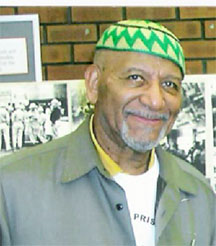Herman Benjamin Ferguson, a former militant African American activist who had been given safe haven in Guyana by then Prime Minister Forbes Burnham, passed away in North Carolina, USA last Thursday,
He will be buried today.
For nearly 20 years, Ferguson had lived in and made contributions to Guyana in the fields of education and the para-military youth-development initiative that was the Guyana National Service (GNS).

Known in Guyana as ‘Paul Adams,’ Ferguson was actually fugitive from American justice who was knowingly offered safe-haven here by Burnham. Since the Americans did not press for Ferguson’s extradition over the two decades, the Burnham administration utilised his varied and considerable skills for nation-building.
Ferguson and a few other African Americans had arrived in Guyana just before this country became a republic. His companions included accomplished artist Tom Feelings and David Hill, who was introduced to the administration by Eusi Kwayana. Hill was to become ‘Rabbi Washington’ of the House of Israel notoriety.
Ferguson held degrees in aspects of education and was once a principal in the New York education system. He was therefore invited to head a newly-established Materials Production Unit (MPU) of the Education Ministry’s Curriculum Development Centre. The MPU’s mission was to produce some of the new republic’s first supplementary readers for the primary school system. This assignment flowed from a request from Burnham himself.
Teachers/writers/editors comprised the MPU. Among them were Barbara Greaves, Sybil Cort, Olive Austin, Evelyn Wallace, Vivienne Patrick, Ovid Isaacs, Puran Chattoram, Harry Persaud and Allan Fenty. Artists/illustrators included Feelings, Emerson Samuels, Victor Davson and Harold Bascom.
Between November 1971 and 1980 numerous publications were produced. The MPU team then fanned out across every region to introduce the readers to schools and parents, equipped with Teacher’s Manuals.
The MPU then morphed into the Guyana National Service Publishing Centre, located in Ruimveldt Industrial Site, Georgetown. The expansion saw the beginning of widespread educational and commercial printing. Ferguson was at the helm. His wife Iyaluua became a naturalised Guyanese and contributed her formidable educational skills.
Ferguson was to be transferred to the Guyana Defence Force before deciding to give himself up to his country’s justice system around 1988. But who was he?
Herman Ferguson was a mild-mannered merchant-navy serviceman and a North Carolina/Ohio/New York educator who became aggressively militant in the face of the rampant racism of America of the fifties and sixties. He converted to Black Power Consciousness and knew such militants of the time as Rap Brown, Huey Newton, Stokely Carmichael, Sonny Carson and Angela Davis.
But it was Malcolm X who would have the most profound effect on Ferguson’s struggle with White American supremacy. Malcolm welcomed him as follower then colleague. Up to his death days ago, Ferguson perpetuated Malcolm X’s work, objectives and ideals in an organisation with Malcolm’s name.
Ferguson was probably the last stanchion of that Black Consciousness and Independence era. Today’s funeral in North Carolina is bound to attract both old and young familiar with that struggle. And if they were aware of his passing, both Norman McLean and Desmond Roberts might be among those lighting candles worldwide.
Christopher ‘Kit’ Nascimento once described Ferguson as “a quiet American, not an ugly American.” Ferguson’s biography An Unlikely Warrior, was released last year.





